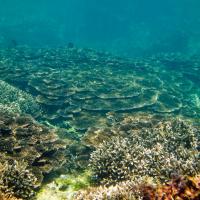Global warming could impact the El Niño Southern Oscillation (ENSO), altering the cycles of El Niño and La Niña events that bring extreme drought and flooding to Australia and many other Pacific-rim countries.
New research published in Nature Geoscience using coral samples from Kiribati has revealed how the ENSO cycle has changed over the past 4300 years. This research suggests that external changes have an impact on the strength and timing of El Niño events.
“Our research has showed that while the development of La Niña and El Niño events is chaotic and hard to predict, the strength of these events can change over long time spans due to changes in the global climate,” said one of the paper’s authors Dr Steven Phipps.
“For instance, we found that the ENSO cycle was much weaker 4300 years ago than it is today. This weaker cycle persisted for almost two centuries.”
The researchers determined that natural influences on the Earth’s climate, such as those caused by variations in its orbit around the sun, could affect the strength of El Niño events.
Although small, these natural influences altered seasonal trade winds across the Eastern Pacific and affected the development of El Niño events. Interestingly, the research also showed that El Niño events in the past started later in the year and were often less intense.
“We found there was a small strengthening of the regular seasonal trade winds in the Eastern Pacific in response to natural warming cycles in the Earth’s orbit around the sun. Remarkably this acted in a big way to stop El Niño events from forming and growing,” said lead author Dr Helen McGregor from the University of Wollongong.
“This shows us that external factors can influence the ENSO process and that it may have a sustained response to future greenhouse gas changes. Currently 20th Century observations are too short to confirm whether this is occurring now.”
Importantly, these new observations can now be used in climate models to see if these past changes in ENSO processes can be reproduced.
“Currently, climate models do not agree on how El Niño may change under future global warming scenarios,” said Dr Phipps
“With these new observations we can determine which models reproduce the most accurate response to changes in the global climate. This will help us to more accurately forecast the response of ENSO under future global warming scenarios.“


